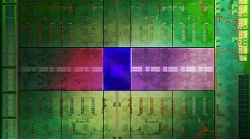Nvidia admits mobile is taking over, decides to let others in on its GPU game
First on the block is Kepler

Nvidia may be missing from the Xbox One and PS4, but the chip maker is about to start a whole new racket, one that could see its silicon in everything from smartphones to supercomputers.
In a blog post, David Shannon, executive vice president, general counsel and secretary of Nvidia, announced today that the company will begin licensing its GPU core tech based on the Kepler architecture.
With DX11, OpenGL 4.3 and GPGPU capabilities, Shannon wrote that a whole new class of licensable GPU cores is about to land.
Kepler is the groundwork for its GeForce, Quadro and Tesla GPUs, plus Logan, the codename of Nvidia's next-gen Tegra chip.
Big guns
We reached out to Nvidia for word on any potential partners and the time frame for the licensing to get off the ground, and received this response from a company spokesperson:
"We're targeting designers of applications processors for a variety of markets," the spokesperson said. "We're just getting going but we're in touch with several potentially significant customers, none of which we are disclosing today."
As for when these partnerships will poke about, look for them to likely emerge in 2015, "given design and testing requirements."
Sign up for breaking news, reviews, opinion, top tech deals, and more.
Line 'em up
While licensees can look forward to a full swath of Nvidia support as they work to integrate Nvidia's GPU tech into their own devices, Shannon said the company also plans to offer licensing rights for its visual computing portfolio.
But why license its proprietary tech in the first place? The answer lies in the "upended" IT world, one that's seeing PCs overtaken by smartphones and tablets.
"[It's] not practical to build silicon or systems to address every part of the expanding market," wrote Shannon. "Adopting a new business approach will allow us to address the universe of devices."
This actually isn't something new for Nvidia: Shannon noted the company licensed an earlier GPU core to Sony for use in the PS3. Intel, meanwhile, pays it more than $250 million (about £159 million, AU$264 million) a year in licensing fees for visual computing patents.
But is there a specific, driving force behind the decision beyond the fluctuating tech world? You betcha.
"Now, with the explosion of Android devices presents an unprecedented opportunity to accelerate this effort," Shannon wrote.
Though there's a shout out to Android, it also stands to reason that Nvidia could license its chips to Apple for use in its iOS devices. Even Samsung, which usually uses in-house chips, could turn to Nvidia processors if it so desired.
Looks like the sting of Tegra missing LTE capabilities may finally start to fade.
- One chip maker is doing something for the very first time. Read more about AMD's plan for an ARM chip in 2014.

Michelle was previously a news editor at TechRadar, leading consumer tech news and reviews. Michelle is now a Content Strategist at Facebook. A versatile, highly effective content writer and skilled editor with a keen eye for detail, Michelle is a collaborative problem solver and covered everything from smartwatches and microprocessors to VR and self-driving cars.